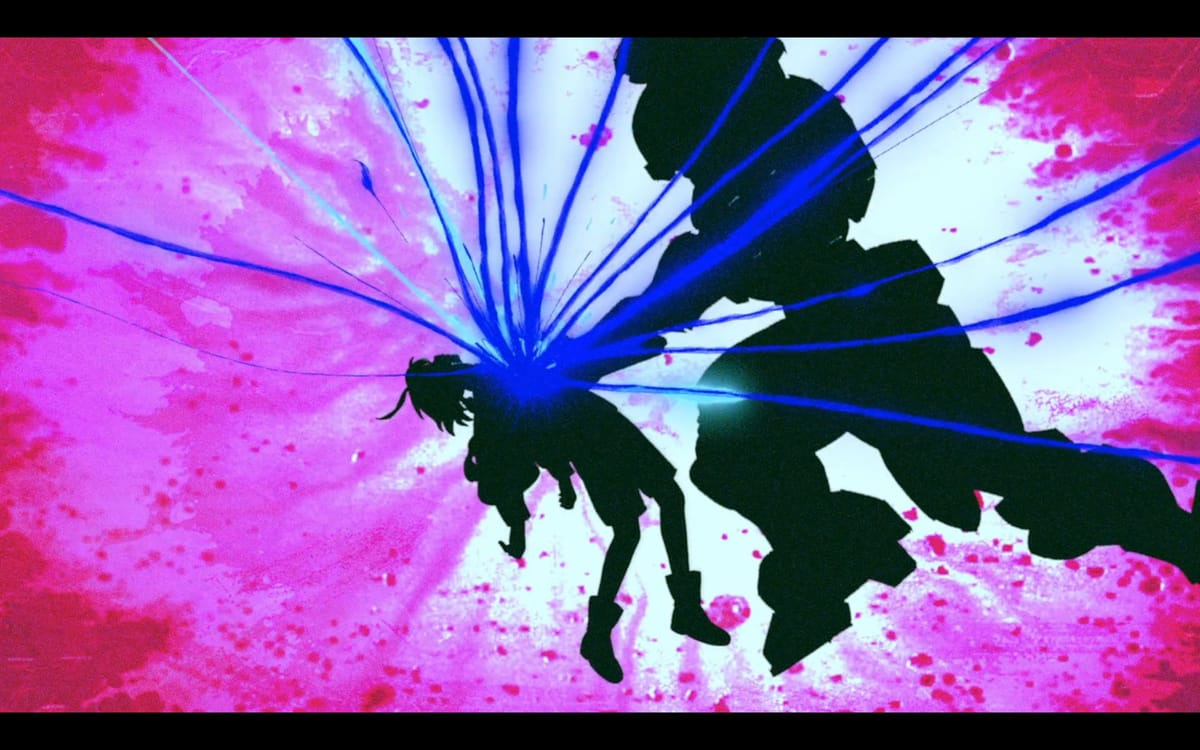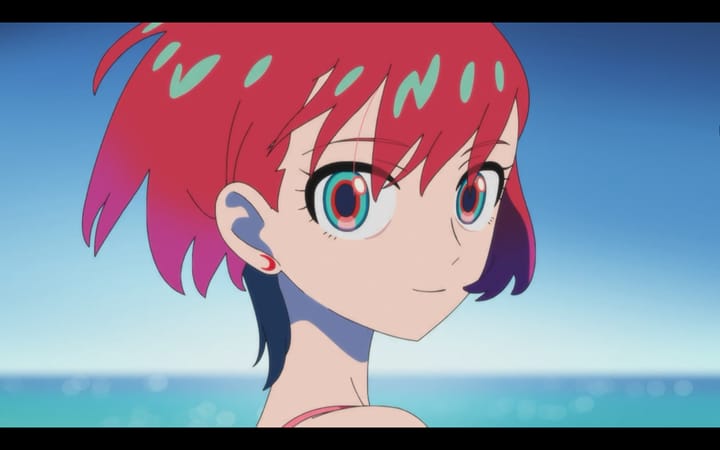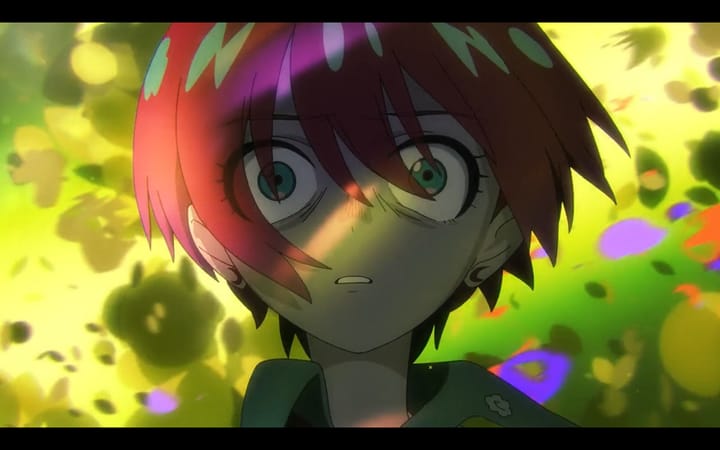LET'S ROCK! My Favorite Opening and Ending Credits of 2023
Here's ten opening and ending anime credits bangers to ring out 2023.

Welcome to ANIWIRE! This week we’re covering my favorite opening and ending credit sequences of the year. Before that, though, here’s some news from the past week.
News
- Hayao Miyazaki’s latest film The Boy and the Heron is coming to theaters in the United States on December 8th. It’s almost here…! There’s also a new music video set to Kenshi Yonezu’s theme song, “Spinning Globe.”
- A new iteration of the mega-popular magical girl franchise Precure has been announced, titled Wonderful Precure! The same day, Henry Kissinger died.
- The beloved, bonkers singing action franchise Symphogear has a new film coming out, plus more (??) Here’s a sample from the third season if you’re curious. “Adjusting K2 to the rank of Earth’s third-highest mountain.”
- Science Saru is adapting the endearing action-comedy-horror-romance trash festival Dandadan into an anime series. More on this later!
Bookmarks
- The internet has been boiling over hbomberguy’s nearly 4 hour video epic about plagiarism on YouTube. I usually struggle to find time for long videos like this, but I’d recommend this one.
- For Anime News Network, Sean Aitchinson wrote about why, exactly, Japan loves Columbo so much.
- For Letterboxd, Alicia Haddick interviewed Godzilla Minus One director Takashi Yamazaki. This film’s been doing pretty well in the United States!
- For Paste, Autumn Wright interviewed composer Joe Hisashi. Some great tidbits in here about his changing creative partnership with Hayao Miyazaki.
- Indie Tsushin interviewed Toshimichi Kuwahara about his team’s recent dungeon crawling RPG, QUESTER.
- For Read Only Memo, Wes Fenlon interviewed Maude, the translator of legendary “kusoge” RPG Hoshi wo Miru Hito.
- For Anime Herald, Samantha Ferreira wrote up Anime News Network’s 25th Anniversary Panel.
- For Tsundoku Diving, Baxter wrote about the action manga classic Karakuri Circus, by genius monster designer Kazuhiro Fujita.
- At Solrad, Hagai Palevsky reviewed about Susumu Higa’s recently translated manga collection Okinawa.
What I’ve Been Writing
- For Comics Beat, I reviewed the historical fiction manga Orb by Uoto. I also wrote about the one volume romantic fairy tale Gold Kingdom and Water Kingdom by Nao Iwamoto.
AMV of the Week
Here’s “Black Country, New Road – The Place Where He Inserted the Blade” by Prostate Constantly.
Anime credits sequences are probably the part of the medium that have given me the most joy over the years. They’re a great way for individual artists to express themselves, or to find a new angle on even the most popular series. Here’s ten that I thought were excellent from this year, divided into opening and ending credit sequences.
THE OPENING CREDITS:
Biggest Pop Sensation: "Idol" by YOASOBI
Oshi no Ko
“Idol” is the anime song of the year. A four minute banger by YOASOBI, its cute and poppy exterior bubbles with mystery and menace. Its accompanying music video on YouTube has been viewed over 380 million times. It’s the fastest song in the history of Oricon to pass 400 million streams, and is the first song originally performed in Japanese to achieve #1 on the Billboard Global Excl. U.S. chart. Per the Japan Times, it represents the final triumph of the Vocaloid scene (represented by folks like megastar Kenshi Yonezu) over Japanese pop music.
All that, and the opening animation is pretty good too! It’s directed and storyboarded by Yusuke Yamamoto, who handled some of the best episodes of 2022’s Bocchi the Rock. Yamamoto packs the sequence with big screens, eyes and ominous imagery that hints at the darkness of Oshi no Ko without stating it outright. I love the shot of protagonist Aqua looking out at a vast faceless audience holding bobbing red light sticks.
Best Opening Credits Sequence: "innocent arrogance" by BiSH
Heavenly Delusion
Weilin Zhang made a big splash this year with his contributions to Luffy’s big battle with Kaido in One Piece. Before that, though, he turned out the opening credits sequence for the sci-fi series Heavenly Delusion. Zhang handled the storyboards, animation and photography. The result is less a traditional opening credits sequence than a Wenlin Zhang mini-movie featuring off-model characters, lens flare and an emphasis on threads and lines (wires, spiderwebs, branches). There are enough hidden jokes and bits of foreshadowing that I’m still finding new ones while writing this piece!
While Zhang’s impulse is often to go big, the last third of the sequence shows comparative restraint. Series heroine Kiruko sprints forward while the sun sets. As she struggles, her outline dissociates from her body and she becomes an indistinct silhouette. Her resolute expression is the last thing we see before she and her friend Maru walk away from the camera into the coming night. It’s a simple but elegant distillation of her character that’s a world away from the show’s own indulgences.
Most Adorable Dance: "Mellow" by Keina Suda
Skip and Loafer
There’s nothing like a great dance credits sequence, whether that be the carefully choreographed Hare Hare Yukai or the endearing sloppy “Sugar Song and Bitter Step” from Blood Blockade Battlefront. Skip and Loafer’s sequence isn’t quite as ambitious, only lasting for a third of the total opening credits. But it’s elevated by how true it feels to its excellent source material. Series protagonists Mitsumi and Sosuke dance against a background of changing colors and falling flower petals. At times they trip and fall, or become so embarrassed they lose track of the choreography. We can see from their expressions and movement, though, that they are having fun.
The author of Skip and Loafer has said in interviews that it is a story about communication. In that respect, a dance is a perfect way to express that theme. Mitsumi and Sosuke navigate the same space together through teamwork and careful observation. I don’t know if we’ll ever see folks replicating the dance at conventions like they did the Hare Hare Yukai, but that’s fine! This dance is about them.
Best Homage: "01" by Queen Bee
Undead Unluck
As far as I’ve seen, Undead Unluck is a pretty average Shonen Jump action series about an odd couple fighting bad guys with superpowers. The show’s staff, though, is built of escapees from early 2000s powerhouse Shaft, including director Yuki Yase. I’m going to guess that’s why the opening credits (led by Tsutomu Matsura) are a homage to the work of Tatsuya Oishi, whose aesthetic defined the studio’s golden age. A shot of a tree is seemingly lifted from the Monogatari series, while another of the heroic zombie Andy walking through a field of white objects looks just like something from Sayonara Zetsubou Sensei.
Oishi himself is credited in the sequence as a key animator, which is neat! I don’t know how this sequence compares to stuff like his Sayonara Zetsubou Sensei opening, which still looks unlike anything else made today. But I’m not immune to being reminded of animation I already like that is hardly made anymore. If I ever watch any more of Undead Unluck, it’ll be because this opening credits sequence rips.
Most Kenichi Kutsuna: Anything by Kenichi Kutsuna
The Fire Hunter, Magical Destroyers
Nobody else does it like Kenichi Kutsuna. He appears on shows like The Fire Hunter and Magical Destroyers that nobody is watching, and then delivers credits sequences that capture some ineffable aspect of the source but remain distinctly his. Kutsuna said in an interview with Full Frontal in July that “I only take the jobs where I have complete freedom,” and it shows. Perhaps he’d become a bigger name if he took opportunities on popular Shonen Jump series like Jujutsu Kaisen. But Kutsuna sticks to what he likes best: telling stories about water, plants and fabric in a minute and a half.
If I was asked to pick my favorite of his from this year, I’d go for his credits for The Fire Hunter if only because it captures that epic fantasy atmosphere. It even has a shout-out to Record of Lodoss War! Magical Destroyers is hard to top, though. Not only does it have a fetishistic sequence where the protagonist vomits a fish into a glass, but you have Kutsuna’s colleague Yoko Yuki taking the wheel for the second half and driving the sequence into GLITCH HELL. Either way, I'm overjoyed that we were given two of these this year. What a gift.
THE ENDING CREDITS
Most Nostalgic: "more than words" by Hitsujibungaku
Jujutsu Kaisen
Jujutsu Kaisen’s been lucky enough to have some of the best recent credit sequences for modern action anime, from Shingo Yamashita’s iconic opening credits to ALI’s “Lost in Paradise.” But while King Gnu’s “SPECIALZ” has been tearing up the charts this year, it’s the ending sequence “more than words” that has stuck with me. If I was to say why, it would be that watching it evokes nostalgia–even for a show I’ve barely seen! With the Shibuya Incident dominating the second half of the series, the audience needs a reminder each week of what the cast have to lose. The hazy memories of afternoon photos and local landmarks conjured by “more than words” is just right.
Jujutsu Kaisen’s second season has become a talking point of late due to its disastrous management behind the scenes. This ending credits sequence is a reminder that everybody on this team is able to do excellent work in the right conditions. So long as the studio’s producer keeps insisting on the wrong conditions, though, anime’s future will continue to deteriorate.
Most Flowers: "Anytime, Anywhere" by milet
Frieren: Beyond Journey's End
I found Frieren: Beyond Journey’s End’s opening credits sequence to be a misfire, technically competent but missing the source material’s most distinctive qualities. The ending sequence, though, is a lot better. hobohun’s animation weaves the source material’s theme of “time” into a tapestry of moons, flowers and seeds. The mood of the piece is joy and bittersweetness, reflecting the beauty of nature and the secret to living a life without regret.
The sequence is aided by milet’s “Anytime, Anywhere,” which strikes just the right tone at the end of an episode. I especially like the transition into the chorus, where Frieren’s staff is thrown into the air as flowers explode from every corner of the screen. Her “special ED” song for the television airing of the first four episodes, featuring extensive illustrations by Kou Yoshinari, may be even better. Sadly it isn’t available in the Crunchyroll release of the series. Bummer!
Deepest Cut: Re-raise by Argonavis featuring 旭 那由多 from GYROAXIA
Cardfight!! Vanguard Will+Dress Season 2
I’ve never watched an episode of Cardfight!! Vanguard, a multimedia franchise in the vein of Beyblade and Duel Masters. But when I heard that Kai Ikarashi, of all people, tackled the ending credits sequence for the show’s second season, I had to check it out. Ikarashi has long been Studio Trigger’s ace in the hole, turning out weird and excellent episodes of SSSS.Gridman and Cyberpunk Edgerunners. Like the aforementioned Kenichi Ketsuna, his work stands out even when you remove him from his normal context and put him somewhere totally unexpected, like an anime series about a children’s card game.
The results are just as wild as I hoped. Ikarashi goes all in on mixed media, combining sketches, torn photographs and even pen illustrations. Fast cuts create the illusion of movement and sell the minimal but effective effects animation. The fact that a sequence like this can just appear out of nowhere is one of the reasons I still love anime. Its successor isn’t bad either! (So long as you like abstract shapes spinning around and around, like me.)
#1 Preying Mantis Appearance: "Vita Philosophica" by Kashitaro Ito
My Happy Marriage
As I’ve written in an earlier installment of ANIWIRE, My Happy Marriage is an old-fashioned but well-made take on the classic Cinderella story. The excesses of the story, like the heroine’s monstrous family or the secretly angelic husband she finds along the way, are just part of the appeal. Yet the ending sequence, storyboarded by Ayaka Tsuji, strips everything back. The heroine is deglamorized, reduced to scratching her bandaged toe in a dark room. Time passes as she walks the dirty hallways of her new home. The stars shine through eerie leaves, and a mantis walks by her sandals.
My Happy Marriage is about the uncertainty of passing from a life you hate into one that you must learn to love. This means a lot of waiting around, of trying to find yourself in the long night between one day and another. Tsuji captures this feeling without needing to lean on the opulent set dressing of the show itself. It was an early sign, for me, that the folks at studio Kinema Citrus were cooking.
Best Ending Credits Sequence: "Red:Birthmark," by AiNA THE END
Mobile Suit Gundam: The Witch From Mercury
How do you sum up “Red:Birthmark,” the ending credits sequence for The Witch From Mercury’s second season? A primal scream in the dark. A witch’s sabbath cum ballroom dance. Breaking through mirrors to the other side, to hold the hand of your shivering reflection. Takashi Ohashi’s return to the series following his pretty good first ending sequence was a vast improvement on his previous work, and probably an all-time achievement in Gundam history. Following its debut, fans flooded the internet with art of witch Suletta and her clone armies dancing with Miorine. They were obsessed!
“Red:Birthmark” features the voice of AiNA THE END, a former member of the idol group BiSH. The song itself, though, was written by TK from Ling Tosite Sigure. Once you know the secret, there’s something uncanny about another singer hitting the notes that TK usually goes for himself. Even so, “Red:Birthmark” is more than the sum of its parts. No other anime theme song goes harder this year.


